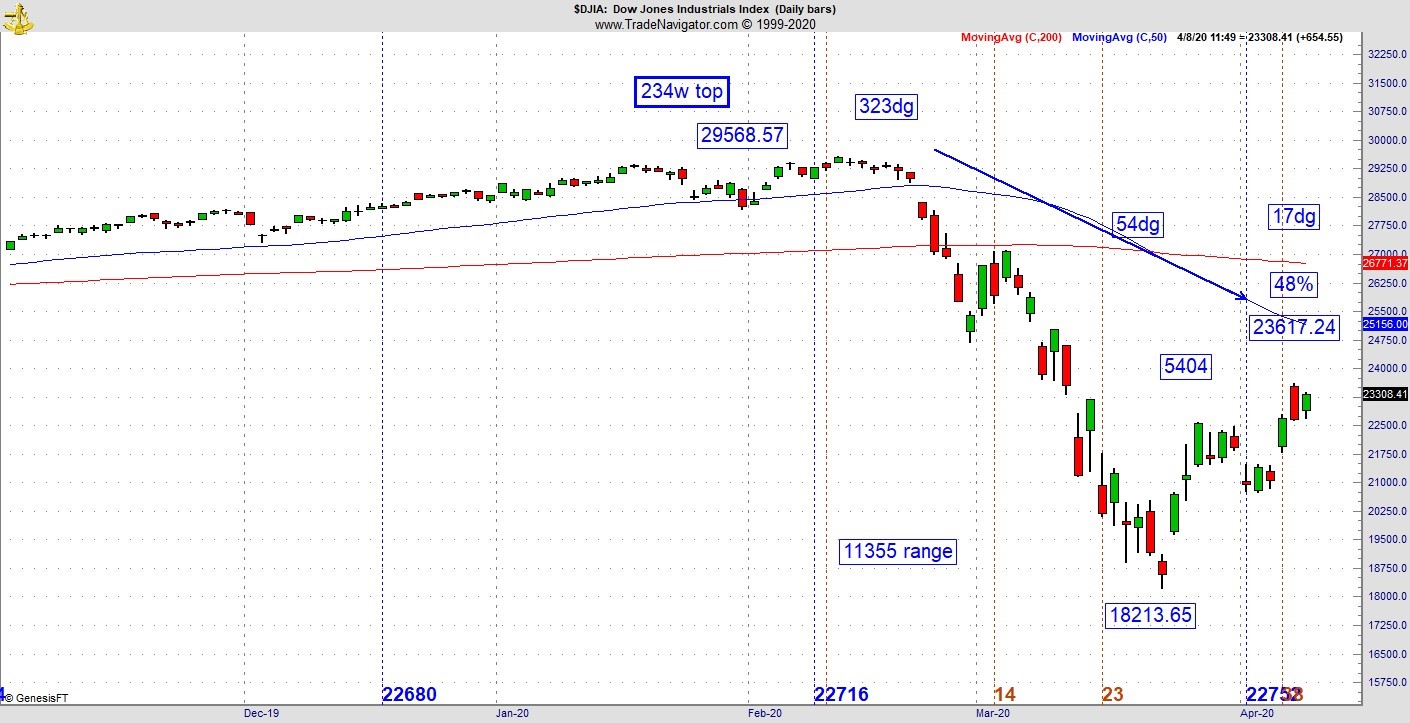Market rebound is being tested, says Jeff Greenblatt.
Tuesday started well enough; the Dow Jones Index was up more than 900 points at the open. By the end, all the gains were lost. It was a classic bearish belt hold bar where it gapped and opened near the high but bearish momentum gained steam throughout the day and it finished right near the low. By Wednesday much of it recovered.
It wasn’t long ago we were talking about an important low at the Gann seasonal change point. Honestly, with everything that’s happened, the March turn feels like a long time ago. If you look at the Dow, perhaps it was. From the low, the Dow rallied 5404 points through Tuesday. To give you an idea, from the December 2018 low it took the Dow nearly seven months to grow 5400 points. Hopefully, you’ve been practicing the concept of no trade is better than a bad one in this environment.
I’m going to limit my comments on the virus exclusively to market related activity. On Monday, markets were up huge on the hopes the curve numbers could be near a peak. If that’s the case, why was the market down so heavily on Tuesday? You must understand we are in a bear market and in bear markets, the rallies are fueled by slopes of hope. Mind you, it has nothing to do with reality and everything to do with perception as the crowd is looking for some form of relief from all the bad news. How many times over the years have I come here to mention the Extraordinary Popular Delusions and the Madness of Crowds?
On the day folks were hoping for some good news, Boris Johnson’s condition became worse, landing him in the ICU. Thankfully, we are getting better news. Let us all pray for Johnson’s recovery. If he has a turn the other way, the market could unleash a fresh leg down. Since we are talking about the Coronavirus, here’s another challenge. Tens of millions of people were promised stimulus checks which they need for rent is going to become an issue in three weeks. The market loved the idea of the helicopter money. But news has leaked out some people might not get their checks for weeks. Other people fell victim to furloughs and layoffs. Yes, many of them will quality for pandemic unemployment insurance, but many states are waiting for guidance from the Labor Department as their own websites are antiquated and not set up to deal with the volume or the new laws. The bottom line is millions of people are waiting on the money, which can’t get to them soon enough. There will be implications on many levels if millions must wait into May to get the help they desperately need. Its this kind of psychology that could refuel a test of the bottom. Right now, the market is not considering any of this. But there’s more.
On April 7, the New York Post ran a story called, “Feds classifying all Coronavirus patient deaths as ‘Covid-19’ deaths, regardless of cause.” The story quotes Dr. Birx, the response coordinator we see everyday at the White House briefings. She said, “There are countries that if you had a pre-existing condition, and let’s say the virus caused you to go to the ICU and then have a heart or kidney issue problem. Some countries are recording that as a heart issue or kidney issue and not a Covid-19 death.” She is counting it as a Covid-19 statistic and was asked if that could skew the numbers. She said that could be a problem in rural areas where testing isn’t implemented on a wide scale.
You’ll recall I brought to your attention there was a problem in the economy when the Federal Reserve started their repo actions last September. The truth of the matter there was a problem with the economy and the bubble would pop sooner or later. It just so happened to be this virus. The virus is the pin, the bubble was always there. Now we have a flawed model because so many who had underlying conditions are being counted exclusively as corona deaths. That could be a problem as last week Dr. Fauci said they could “relax social distancing” once there’s no new cases, no deaths.” The problem is there is no way to connect the cause and effect dots for people who have underlying conditions. Then on Wednesday the market jumped again as Fauci said a virus turnaround could come after this week as the death count is lower than initially thought.
The virus is real, the model is statistically flawed. Given this is the way they are keeping score, how could a market that craves certainty ever get a bull leg up? That’s likely why we are seeing such wild swings from one day to the next. Traders and investors need to consider these things. Let’s say they do start to reopen the economy, could it be yet another case of buy the rumor and sell the news? By that time market participants will be wrestling with the X factor of unintended consequences concerning shutting down the global economy. Put all these issues together and we are likely staring down the barrel of a 1929 style depression.
It’s even more critical now as the charts have come to the crossroads where they either rollover here because there is a calculation for a high or it starts to show some serious staying power. Here’s the thing about working with Kairos readings. If there is a false positive, meaning a reading only gives a small reaction, it means there is something very strong developing in the opposite direction. So, a calculation like this one where one number vibration replicates, it is an important bit of new information. In this case the Dow dropped 11355 points. It rallied 5404 points, so we have a 54/55 vibration working (see chart below).

Turning to the Gann calendar, the high back in February was on the 323 dg vibration day. Tuesday was the 17 dg vibration. That means a 54 dg difference on the high to high. The fact it had a bearish belt on that day should be taken seriously. On Wednesday, a lot of that recovered but the market is not yet out of the woods. There are two camps concerning this market. On the one hand we have the bears who believe the market is going much lower. On the other hand, we have the crowd who never saw a low it couldn’t resist. Given we found the low right on the Gann seasonal change point, the truth is likely to be somewhere in the middle. This market won’t top without some type of a reading and I haven’t said much against this market since the low. But Tuesday’s action proved Monday was fueled by the slope of hope. Wednesday also appears to be more of the same.
Tuesday was also the first bearish day for the U.S. Dollar Index since the bottom (see chart). This one also backed off on an interesting reading on the intraday time frame. By Wednesday’s close it looked more bearish than bullish. What is the bottom line? Putting all the health and political considerations aside, this is classic bear market slope of hope behavior.

If you want more information, go to: Lucaswaveinternational.com and sign up for the free newsletter.





















